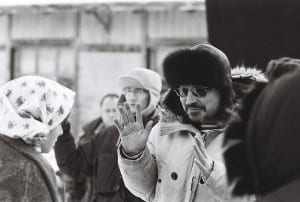Alexei Balabanov: the potency of cinematic story-telling
By Sarah J Young, on 22 May 2013
Alexei Balabanov was as much a cinematic translator as a chronicler of post-Soviet reality, finds Seth Graham
A few days before Alexei Balabanov’s death at age 54 on May 18, I was finishing a blurb for a talented film scholar’s forthcoming book on the director’s work. I wrote: ‘The downside to studying artists who are still alive and working, of course, is that they will always outflank those who study them by creating more art’.
The particularly superstitious might accuse me of hastening Balabanov’s death with this fate-tempting, tongue-in-cheek line (sglazil!). But Balabanov himself did some mortal tempting, and hinting, of his own in his fourteenth and final film, Me Too (2012), in which he appears as a film director who (spoiler alert!) dies an early death. It was not a secret that Balabanov was chronically ill. His relatives, friends and colleagues certainly knew it, and he did not hide it from the public. He said in his last interview that ‘there probably won’t be any more Balabanov films’.
Still, the news of Balabanov’s passing, announced by Sergei Sel’ianov, the director’s perennial producer and co-founder of the CTB production company that funded all of his films for nearly two decades, came as a cruel surprise to Russophiles and cineastes who had gotten used to the regular pleasure of seeing what Balabanov’s latest work had to offer, and which self-designated guardians of Russian culture it would offend.
The latter pleasure was made even more, well, pleasurable due to the fact that Balabanov as an artist typically stayed above such criticism; he was simply not interested in epatage or chernukha or schlock/trash/exploitation or whatever film-studies term you want to use that has been lobbed at filmmakers whose work is considered controversial. He did not make films in order to antagonise or offend or scandalize. He was not the ‘Russian Tarantino’ or even the ‘Russian Scorsese’, despite a similar level of graphic violence combined with formal virtuosity and thematic omnivorousness; Balabanov’s depictions of violence were not, as they often seem to be for Scorsese and other directors, excursus on the nature of violence. His films were excursus on nothing but the concentrated potency of the particular form of storytelling at which he excelled: cinema.
This is not to say that he was a meta-cinematic aesthete (although most of his films do contain explicit references to cinema, most extensively in his gorgeous sepia-toned period film Of Freaks and Men, 1998). His works are certainly not devoid of extra-cinematic meaning; viewers and critics have found and argued fiercely over such ‘meanings’—philosophical, religious, political, sexual—in every one of his films. He stated plainly that he did not make ‘idea films’, but he has been credited with resurrecting (in his international hit Brother [1997] and its sequel Brother 2 [2000]) the very notion of cinema as a repository and foundry for national ideas: ‘he was the creator of the first post-Soviet mythology, the mythology of “brotherhood”’, wrote Andrei Plakhov.
Despite his not unearned reputation as the celluloid chronicler of post-Soviet Russian reality, however, Balabanov was also an avid adaptor, drawing as often on non-Russian as Russian cultural texts, tropes and tricks. He drew on literary sources: Samuel Beckett and Franz Kafka in his early, ‘auteur’ films Happy Days (1991) and The Castle (1994); Erich Maria Remarque’s Three Comrades in It Doesn’t Hurt (2006); Mikhail Bulgakov’s Notes of a Young Doctor in Morphine (2010). Rarely is it noted that his most controversial film, Cargo-200 (2007), was also a literary adaptation, of William Faulkner’s 1931 novel Sanctuary, from which many of the most ‘scandalous elements’ of the film (rapes, murders, kidnappings) are taken more or less directly from the work of that Nobel laureate.
The importance of Russian rock music (especially his fellow Ekaterinburgians Nautilus Pompilius) to his Brother dilogy is clear, as is his knowledge of film history, both domestic and foreign. It often noted that Balabanov was originally trained as a translator, and that might just be a fitting metaphor by which to remember him, at least in the short term: as an artist who absorbed the artefacts and icons and obsessions of the myriad culture(s) around him and drew on them to create new works of art that were legible to—and have become indispensable for—the audience for which they were made: Russians and those of us who often wish we were Russian.
Seth Graham is a lecturer in Russian at UCL SSEES. His research focuses on contemporary Russian culture, particularly cinema, as well as humour theory and gender theory.
Note: This article gives the views of the author(s), and not the position of the SSEES Research blog, nor of the School of Slavonic and East European Studies, nor of UCL.
One Response to “Alexei Balabanov: the potency of cinematic story-telling”
- 1
 Close
Close



Academia Rossica will show 9 of Balabanov’s greatest Films in UK’s biggest Retrospective of the director in the upcoming months!
The program will commence this Saturday 1st February with Brother (1997) and the films will contain English subtitles. The Tickets can be ordered here: http://academia-rossica.org/en/film/the-brother/book-tickets.
We are all very excited!